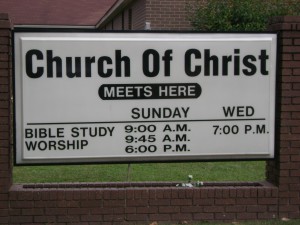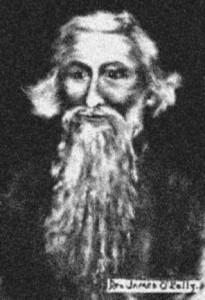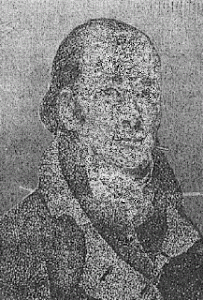 In our Sunday morning Bible classes here at Central, we’re studying the history of our Churches of Christ within what is called the American Restoration Movement. The hope and prayer is that we, in the words of Doug Foster, “raise our historical spiritual consciousness,” that we come to understand how our distinctive faith and doctrines and practices have been shaped by particular history and culture in order to better grasp the founding vision of our movement and make a deliberate turn back to the best parts. And if you’ve made it past those two sentences to this one, congratulations. Sorry about that.
In our Sunday morning Bible classes here at Central, we’re studying the history of our Churches of Christ within what is called the American Restoration Movement. The hope and prayer is that we, in the words of Doug Foster, “raise our historical spiritual consciousness,” that we come to understand how our distinctive faith and doctrines and practices have been shaped by particular history and culture in order to better grasp the founding vision of our movement and make a deliberate turn back to the best parts. And if you’ve made it past those two sentences to this one, congratulations. Sorry about that.
We’re using Foster’s book, Renewing God’s People, to guide our study and discussions. I’m sharing the fruits of our study and openly processing some of it in this space. You might look at yesterday’s post if this one’s going to make sense.
It was during the prolific exercising of “religious freedom” in the colonial days of the American frontier when the call for “restoration” became a popular cry among Christians. The denominationalism of the day couldn’t be good for the spread of the Gospel. The constant dividing and splitting and planting and branching probably wasn’t communicating the truth of unity in Christ. There seemed to be no end to the numbers of new churches and new forms of Christianity that were being established in the States based on somebody’s new or different interpretation of the Scriptures. Finally, a few church leaders began questioning whether new churches and new denominations, the exercise of this nationalistic and democratic and individualistic religious freedom, was actually harming their Christian witness. Some religious leaders went so far as to say this denominationalism was a direct affront to the prayer of our Lord in John 17 in which Jesus prays for unity among all believers “so the world may believe.” Denominationalism, in their view, was in fact a sin.
 James O’Kelly (1735-1826) was one of these guys. A Methodist preacher in North Carolina and Virginia, O’Kelly openly questioned the power and authority of the bishops in the Methodist church, particularly the two in Baltimore. He balked at the whole bishop system, arguing that each Christian congregation should act democratically, like a republic, to govern its own affairs. His motto was “Bible government, Christian equality, and the Christian name!” In 1793, he formed the “Republican Methodists.” Then he went even farther the next year, dropping the name “Methodists” alltogether. We are only Christians, he said, “Christian” is the only name for disciples of Jesus.
James O’Kelly (1735-1826) was one of these guys. A Methodist preacher in North Carolina and Virginia, O’Kelly openly questioned the power and authority of the bishops in the Methodist church, particularly the two in Baltimore. He balked at the whole bishop system, arguing that each Christian congregation should act democratically, like a republic, to govern its own affairs. His motto was “Bible government, Christian equality, and the Christian name!” In 1793, he formed the “Republican Methodists.” Then he went even farther the next year, dropping the name “Methodists” alltogether. We are only Christians, he said, “Christian” is the only name for disciples of Jesus.
In that same year, 1794, O’Kelly published his Cardinal Principles of the Christian Church:
~ The Lord Jesus Christ is the only Head of the Church
~ The name Christian should be used to the exclusion of all party and sectarian names
~ The Holy Bible is our only creed, and a sufficient rule of faith and practice
~ Christian character is the only test of church fellowship and membership
~ The right of private judgment and liberty of conscience are the privilege and duty of all
~ The union of all followers of Christ to the end that the world may believe
What do you think about those six rules? Is this a fairly decent summary of standards and practices for a Christian church based on the Gospel of Jesus? What would you add to a list like this? What would you subtract? Could a church or a group of churches even function with this type of charter? Could a group of churches — Churches of Christ, maybe — function this way today?
O’Kelly’s churches grew to about ten thousand members in North Carolina and Virginia. They eventually adopted believer’s baptism by immersion as their standard practice and taught that the unity of all Christians is God’s plan for redeeming the world.
At the same time, a group of Baptists in Vermont led by Abner Jones (1772-1841) and another group of Baptists in New Hampshire led by Elias Smith (1769-1846) began to independently proclaim a non-creedal Christianity. They denounced Calvinism and took the name “Christian” as the only acceptable label for disciples of Jesus. These two, again independently of one another, established at least fourteen churches in the early 1800s.
Funny, huh? Barton Stone and Alexander Campbell weren’t the first ones or the only ones with these kind of ideas. The idea of “restoration,” stripping away what is new and unnecessary to get back to something in its pure and original condition, actually was fairly popular at the turn of the 19th century. It was being preached and practiced by many. And Jesus’ prayer for unity in John 17 was driving it.
“…that all of them may be one, Father, just as you are in me and I am in you. May they also be in us so that the world may believe that you have sent me. I have given them the glory that you gave me, that they may be one as we are one: I in them and you in me. May they be brought to complete unity to let the world know that you sent me and have loved them even as you have loved me.” ~John 17:20-23
Peace,
Allan
Leave a Reply